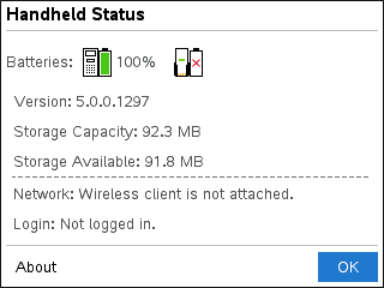When managing the power for the Lab Cradle, you must consider the power source being used. The Lab Cradle can be powered by its rechargeable battery or a connected power cord.
Batteries
The Lab Cradle runs on a rechargeable battery that supports one full day of high-use, high-consumption sensor data collection before recharging. An example of high-use data collection is an experiment requiring 150 total minutes of continuous data collection with CO2 (47 mA) and O2 sensors at one sample every 15 seconds.
The battery recharges in less than 12 hours.
Viewing the Battery Status
There are two ways to view battery status: when attached to a handheld, or by looking at the LED light. When the Lab Cradle is attached to a TI-Nspire™ handheld, you can view the battery status for both. The first value is the handheld and the second value is the Lab Cradle.

| ▶ | Press c 5 (Settings) 4 (Status). |
When you attach the Lab Cradle directly to a computer, you do not see a power indicator. Use the LED light on the top of the Lab Cradle to determine battery status.
|
|
TOP |
|
Battery |
|
When the Lab Cradle is connected to a USB power source (either wall charger or computer):
| • | Red - Slow blinking LED indicates the charge is low but charging. |
| • | Amber - Slow blinking LED indicates the Lab Cradle is charging |
| • | Green - Slow blinking LED indicates the Lab Cradle is fully charged. |
When in the TI-Nspire™ Cradle Charging Bay:
| • | Red - Solid LED indicates the charge is low but is still charging. |
| • | Amber - Solid LED indicates the Lab Cradle is charging. |
| • | Green - Solid LED indicates the Lab Cradle is fully charged. |
When running and not charging:
| • | Red - Blinking LED indicates the battery is below six percent. |
| • | Amber - Blinking LED indicates the battery is below 30 percent. |
| • | Green - Blinking LED indicates the battery is between 30 percent and 96 percent. Two green blinks per second indicates the battery is over 96 percent. |
Managing Battery Power
When the battery power reaches 30 percent, a yellow LED indicates the Lab Cradle needs to be charged. The LED turns red when the battery power reaches five percent.
When managing battery power for the Lab Cradle, remember that some sensors need to warm up before use. You can collect data while the sensor is warming up; however, the data may not be as precise.
When you start a long-term or remote data collection, the system checks current power sources to determine if the sources are adequate to support the sensors from the beginning to the end of the experiment.
If the power is unable to support the experiment configuration, a warning indicates that the power available is insufficient for the experiment. You either need to charge the battery or plug the Lab Cradle into an external power source.
When using the wall charger, TI-Nspire™ Cradle Charging Bay, or USB cable plugged into a powered computer, the Lab Cradle can be fully charged from a dead state in less than 12 hours when not being used.
The battery is capable of supporting one full day of high-use, high-consumption sensor data collection or two full days of moderate to low consumption sensor data collection.